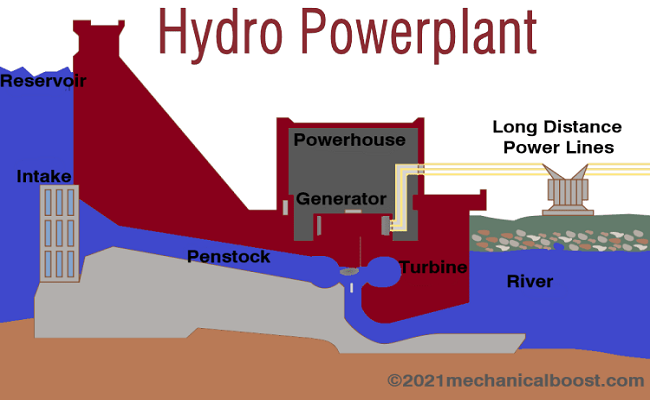It is believed that more than half part of the world’s electricity needs is met by thermal power plants. In these power plants, some fossil fuels (such as coal) are burned to produce steam utilized to run steam turbines. For this reason, a thermal power plant is sometimes referred to as a steam power plant. After it has passed the turbine, the steam condenses in the condenser and is returned to the boiler to transfer it again into steam. This whole process or cycle is known as the Rankine cycle. The steam power plant works on the Rankine cycle. This article describes how thermal power plant generates electricity.
Post Contents
What is a Thermal power station?
A thermal power plant is a power plant that converts thermal energy into electrical energy. Fuel is commonly used to boil water in a large pressure vessel to produce high-pressure steam that powers a steam turbine connected to a generator. The low-pressure exhaust gas from the turbine passes through the condenser and circulates to the heating station. This is known as the Rankine cycle. Natural gas can also be burned directly in a similar gas turbine connected to a generator.

Hydroelectric power plants (hydropower) do not fall into this category as they convert the positional energy of the water into electrical energy through a hydraulic turbine.
Thermal power plants are available in different designs depending on the expected output. Fossil fuels, nuclear energy and geothermal energy, solar energy, biofuels and waste incineration are used. Some thermal power plants are also designed to generate heat for industrial purposes, district heating or seawater desalination, and to generate electricity.
Thermal power plants are available in different designs depending on the expected output. Fossil fuels, nuclear energy and geothermal energy, solar energy, biofuels and waste incineration are used. Some thermal power plants are also designed to generate heat for industrial purposes, district heating or seawater desalination, and to generate electricity.
Read also: Tools to Combine PDF
Why thermal power plants are required?
Thermal power plants are based on the old method. The demand for electricity increases day by day. Compared to nuclear, solar and hydropower plants, these are relatively low electricity costs that help meet electricity needs.
Many countries have clean power and renewable power plants, but coal-fired power plants are heavily involved in producing large amounts of electricity for us.
- Coal is readily available
- Coal is cheap
- Solar and nuclear power plants are too expensive.
- Hydropower plants are based on the availability of hydropower plants.
- Installed renewable energy power plants cannot meet the requirements.
- Large quantities of coal are available in many countries.
Thermal Power Plant Parts
The thermal power plant has the following major components:
- Water treatment plant
- Coal handling system
- Ash handling system
- Boiler feed pumps
- Chimney
- FD & ID fans
- ESP
- Boiler
- Generator
- Cooling tower
- Turbine
- Circulating pumps
- Condensate extraction pumps
- Condenser
1) Coal
In coal-fired power plants, coal is transported from the mine to the power plant. Hard coal or lignite are often used as fuel. The coal is stored in a “death camp” or “living camp”. A dead bunker is usually a 40-day reserve coal bunker that is used when coal is not available. The residential camp is a raw coal store in the boiler room. If there are iron particles that can wear out the device, use a magnetic cleaner to clean and filter the charcoal. The living bank coal is first crushed into small particles and then put in a grinder to make a powder. Coal dust burns completely and coal dust improves the efficiency of the boiler. The ash that arises after the coal is burned is removed from the boiler and disposed of properly.
2) Boiler
A mixture of coal dust and air (mostly preheated air) is transported to the boiler and burned in the combustion zone. When the fuel is ignited, a huge fireball forms in the center of the boiler, from which a lot of thermal energy is radiated. It uses thermal energy to convert water under high pressure into hot steam. The steel pipe runs along the boiler wall, where the water turns into steam. The flue gas from the boiler passes through the superheater, economizer, and air preheater and is finally released into the atmosphere from the chimney.
Read Also: Internet Provider










